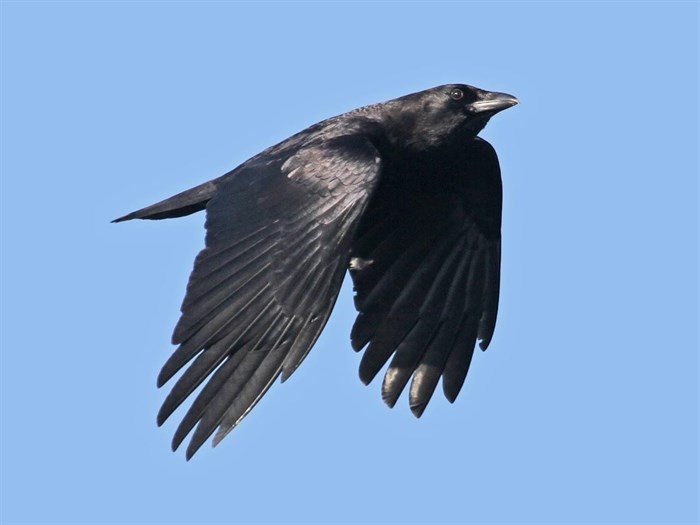
An American Crow, Cornell Laboratory of Ornithology.
Image Credit: Henry Burton
July 09, 2020 - 7:30 AM
If you hear a crow say "hello," you're not going crazy.
A video surfaced last week of a crow in Kamloops very clearly saying "hello," and it's not the only one making small talk.
"We've had a 'hello' crow sitting on our tree here for 26 years," said Kamloops resident Cindy Einhorn. "He sits in there, yaks away, says hello to everybody."
The crow is outside her home almost every day, Einhorn said. Sometimes if you call out, he will reply with "hello." Other times he just says it on his own.
According to TRU bird expert Dr. Tom Dickinson, this behaviour isn't just limited to one crow, or even one word.
"It’s not uncommon for crows to actually mimic different sounds and words," he said. "When I was in China, I went to a zoo… one of the corvids was saying 'Ni hao,' which is hello in Chinese."
The corvid family, which includes crows, ravens and jays, among others, are a highly intelligent group of birds.
The sounds they mimic can range from words they hear frequently like "hello," to sounds they find interesting, like a washing machine or a cat's meow.
Although it may seem like these crows are just sharing a friendly greeting, they mimic for a different reason.
"They pick up the sounds because they form little private communication networks," Dickinson said. "They can say things in a way that their mates and their family members will recognize, but will be private in conversation."
It's likely that one crow copied the behaviour from humans and over time other crows learned to say "hello" too, he said.
Crows can be heard saying "hello" fairly often around the BC Wildlife Park, zookeeper Larissa Deneault said. There is even a wild raven that mimics the "toot toot" of the Wildlife Express Train, she said.
Deneault has been working with the park's resident raven Igor for several years, and has seen his unique behaviours firsthand.
"Here at the park, (Igor) was vocalizing and it sounded like one of our zoo keepers," she said. "A keeper went into the building and thought that it was a person talking."
Igor is given daily enrichment items which help keep his mind sharp, and can solve a multitude of puzzles to get food.
Crows and ravens also have the ability to fashion and use tools for their benefit, Dickinson said.
Crows have also been known to drop nuts onto the road in front of a passing car so that I will crack under the tires. Once the car passes, they fly down to retrieve it.
"They will take calculated risks, if they are scavenging or eating something off of a roadway," Deneault said. "They can make calculated decisions whether they want to fly off of the road or if they could just duck under the vehicle."

An American Crow in flight, Cornell Laboratory of Ornithology.
Image Credit: Ryan Schain
Crows are a very social animal, and are often seen flying or congregating in large numbers. Ravens are more solitary, and are usually seen alone or in a pair.
The younger crows will also help their parents raise new offspring. Families of crows can reach up to 15 individuals consisting of offspring from consecutive years, Deneault said.
Just as crows learn to mimic sounds or words from each other, they also learn threats.
The University of Washington conducted an experiment with crows by exposing them to a threatening figure wearing a mask. Every time the crows were presented with the mask, they reacted as they would to a threat, even crows that had not seen the mask before.
Dickinson explained that this is due to cultural transmission.
"The offspring were looking at the parents reacting to different masked individuals," he said. "The same way they’d learn to be afraid of any other threat."
Crows and ravens are undoubtedly very intelligent birds. Fortunately for those interested in them they are common in urban areas and comfortable around humans.
So next time you see a crow, say "hello." It just might say "hello" back.
To contact a reporter for this story, email Brie Welton or call (250) 819-3723 or email the editor. You can also submit photos, videos or news tips to the newsroom and be entered to win a monthly prize draw.
We welcome your comments and opinions on our stories but play nice. We won't censor or delete comments unless they contain off-topic statements or links, unnecessary vulgarity, false facts, spam or obviously fake profiles. If you have any concerns about what you see in comments, email the editor in the link above.
News from © iNFOnews, 2020